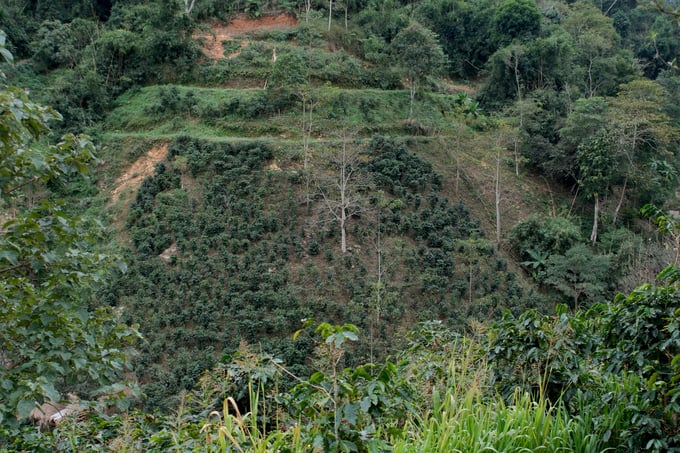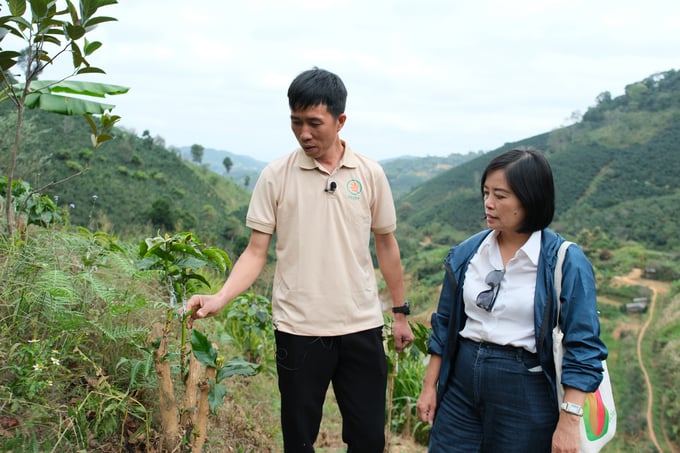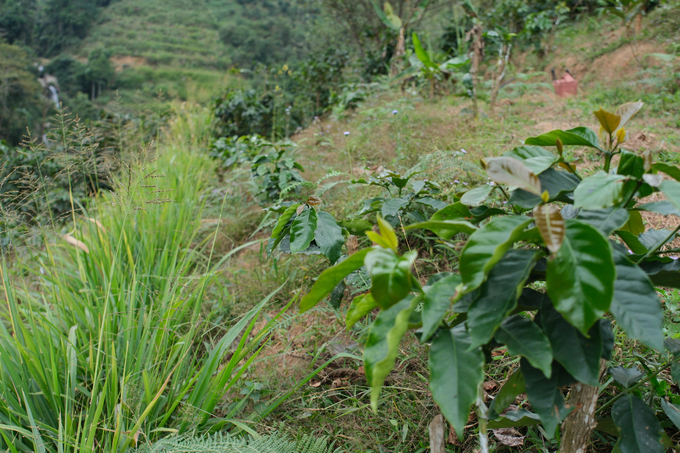May 29, 2025 | 15:44 GMT +7
May 29, 2025 | 15:44 GMT +7
Hotline: 0913.378.918
May 29, 2025 | 15:44 GMT +7
Hotline: 0913.378.918

The agroforestry model applies the solution of growing coffee trees in combination with shade trees. Photo: Quynh Chi.
For the residents of Nam Village (Chieng Chung commune, Mai Son district, Son La province), arabica coffee is a key crop with significant economic value. However, local farmers face numerous challenges in cultivation due to climate change.
At an altitude of 1,500 meters above sea level, thick winter cloud cover makes coffee trees highly susceptible to rust disease. During the dry season, despite efforts to till the soil and fertilize, the trees often wither and die from a lack of water. Additionally, farming on steep mountain slopes presents considerable difficulties.
According to Mr. Ha Van Thao, a coffee grower in Chieng Chung commune, local farmers have long relied on traditional knowledge passed down through generations. Many habitually clear all the grass from their coffee gardens, believing it keeps the fields clean.
“This method lacks scientific basis. Removing all ground cover causes coffee trees to lose moisture during the dry season, making them more vulnerable to wilting from morning fog and ultimately reducing productivity. In winter, the trees also suffer severe damage due to heavy frost,” Mr. Thao shared.
Research by the Northern Mountainous Agriculture and Forestry Science Institute (NOMAFSI) indicates that arabica coffee is highly sensitive to even minor changes in weather conditions. Variations in rainfall patterns can alter flowering, fruit ripening, and harvesting times. Meanwhile, temperature fluctuations increase pest and disease outbreaks, sometimes leading to the emergence of new pests and diseases.
To address these challenges, sustainable farming techniques are essential. These include soil coverage, planting and maintaining shade trees, water conservation practices, the introduction of improved coffee varieties, and the adoption of integrated pest management strategies.

Mr. Ha Van Thao (left) and ASSET project expert (right) visit a coffee garden in Nam village. Photo: Quynh Chi.
As part of the "Agroecology and Safe Food System Transitions in Southeast Asia" (ASSET project), domestic and international experts have introduced an agroforestry model centered around coffee cultivation to support farmers in Mai Son.
Research conducted by the Northern Mountainous Agriculture and Forestry Science Institute (NOMAFSI) and the French Agricultural Research Centre for International Development (CIRAD) focuses on improving crop resilience against extreme weather conditions.
One key approach involves planting grass strips to prevent soil erosion, combined with shade trees. These shade trees help mitigate intense sunlight, stabilize temperature fluctuations, and, most importantly, protect coffee plants during winter by reducing damage caused by extreme cold and frost.
In addition to shade trees, farmers in Nam Village apply contour planting techniques using grasses and legumes. This method creates an effective erosion control system, preventing soil nutrient loss and improving land sustainability.
Beneath the coffee trees, farmers grow fodder grasses, which they harvest and ferment to feed cows and goats year-round. This practice has helped them reduce livestock feed costs by up to 80%.
With this abundant feed supply, Mr. Ha Van Thao has expanded his livestock, raising 10 cows, 30 goats, and a flock of native chickens. He shared: “We compost cow and goat manure with probiotics, as advised by project staff. The treated manure is then used as fertilizer for the coffee plants, significantly lowering fertilizer costs while protecting the environment.”

Grass strips create contour lines, protecting the newly grafted coffee trees using the project's techniques. Photo: Quynh Chi.
Nam Village currently cultivates approximately 50 hectares of coffee, with 45% of the area adopting agroecological practices after two years of participating in the ASSET project. Thanks to this model, Mr. Ha Van Thao’s coffee garden – home to over 13,000 trees – has seen a threefold increase in yield, with this year’s harvest expected to reach 14 tons. At an average price of 20,000 VND per kilogram of fresh coffee, he anticipates a profit of around 200 million VND, a remarkable improvement from previous years.
However, after years of cultivation, productivity began to decline—fruits became smaller, and tree growth weakened. Recognizing the potential for revitalizing Arabica coffee production in Nam Village, the ASSET project team introduced pruning and grafting techniques to restore tree health and enhance yields. Experts guided farmers in grafting new coffee varieties onto aging trees with strong root systems, helping rejuvenate their gardens.
Compared to planting new coffee trees, which take at least three years to mature and bear fruit, grafted shoots can start producing as early as the second year. These grafted varieties are carefully selected to thrive in shaded environments while ensuring stable productivity under shade trees.
Within the project's framework, Dr. Rigal Clement (CIRAD) and his research team identified two hybrid varieties, Starmaya and Centroamericano, as highly suitable for shaded coffee cultivation while maintaining high yields.

Arabica coffee is the main crop in Chieng Chung commune (Mai Son district, Son La province), bringing high economic value. Photo: Quynh Chi.
The project aims to produce 80,000 to 100,000 F1 hybrid seedlings and 500,000 to 700,000 seedling seedlings per year by 2025. To achieve this, micro-cutting technology will be applied to propagate both coffee plants and shade trees, contributing to sustainable development in the region.
Previous studies highlighted Leucaena trees as excellent shade providers for coffee plants. However, local farmers often hesitated to plant them, believing they offered no additional economic benefits.
Building on this insight, the ASSET project team explored alternative options and identified the black starfruit tree as an ideal solution. Not only does it provide effective shade, but it also yields fruit, offering an additional source of income.
Black starfruit is a traditional food in Thai ethnic cuisine, often eaten with sticky rice and grilled fish. Farmers enthusiastically supported its introduction, hoping that within 3 - 4 years, the trees would begin producing fruit, further boosting economic value alongside coffee cultivation.
Translated by Quynh Chi
/2025/05/25/4127-3-073637_820.jpg)
(VAN) Thanks to the promotion from an FAO-implemented project, vegetable production in greenhouses in Moc Chau has seen strong development, from 1.5 hectares in 2021 to nearly 50 hectares in 2024.

(VAN) FAO has recently supported USD 140,000 to implement the project 'Risk mitigation human-animal interface risks through disease control initiatives in pig farming.'

(VAN) The People's Committee of Tra Vinh province has approved an adjustment to the investment policy for the Green Hydrogen Plant project, increasing its area to approximately 52.76 hectares.
![Reducing emissions from rice fields: [2] Farmers’ commitment to the soil](https://t.ex-cdn.com/nongnghiepmoitruong.vn/608w/files/news/2025/05/05/dsc08881jpg-nongnghiep-140632.jpg)
(VAN) Clean rice cultivation model in Thuong Tan commune, Bac Tan Uyen district, is assisting local residents in achieving sustainable agriculture by substantially reducing costs, increasing productivity, and protecting the environment.

(VAN) At the conference to disseminate Resolution No. 68, AgriS introduced its digital agricultural ecosystem and reaffirmed its commitment to accompanying the Government in promoting private sector development and sustainable agriculture.

(VAN) 'Blue Ocean - Blue Foods' initiative is designed to restore marine ecosystems and establish sustainable livelihoods for local communities by cultivating a minimum of 1,000 hectares of cottonii seaweed in the first three years.
/2025/05/21/4642-3-112707_603.jpg)
(VAN) The V-SCOPE project has made direct contributions to three out of six pillars of the Comprehensive Strategic Partnership between Vietnam and Australia.